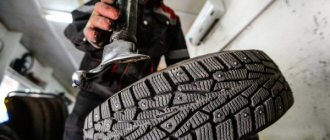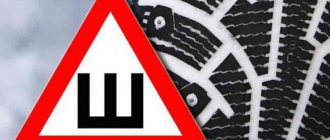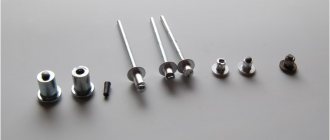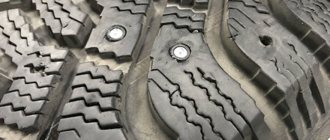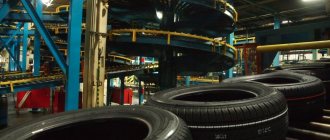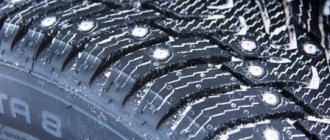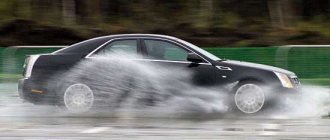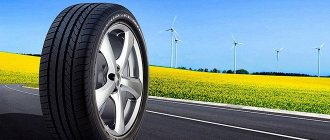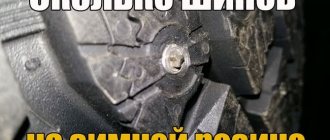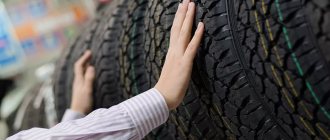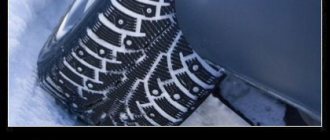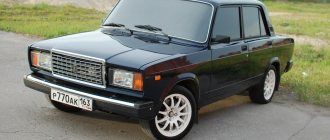Anyone who has ever bought winter tires, and hopefully the vast majority of them, is familiar with the agony of choosing between a studded tire and the so-called “Velcro.”
The latter has become widespread in Europe, where they pay considerable attention to automobile safety, but how justified is its use in our road and climatic conditions? The European winter is reminiscent of our late autumn - cold, nasty, but most importantly - dry and snowless. Indeed, in such conditions, a tire without studs performs excellently, but we are not taking tires for the fall, or even for moving to Europe, so let's talk in detail.
Winter "handling"
“Frost and sun” and, of course, snow - this is why most people love winter. And this is precisely why drivers should not like her.
Firstly, snow accumulating on the roadway quite quickly turns into a durable crust, and then into ice. Both of these surfaces are similar in properties - they are extremely slippery, moreover, the snow is also not stable: it can crack and fall off. In a word, the picture is not the most joyful. Secondly, when the air temperature drops, a car tire also changes its properties. The rubber compound developed for warm summer conditions “tans”, its contact patch with the road decreases, as a result of which the grip decreases. Thirdly, the bright winter sun warms up the road surface during the day, forming a thin layer of water on the already slippery surface.
It would hardly be appropriate to talk about complete control of the car in such conditions. Rather, we will talk about how to preserve the maximum from the former summer controllability. Let's go in order.
One more question,
How many studs can you put on tires? First, let's look at the types of tires: European, Asian and Russian. More recently, studded tires were not allowed in Europe; today such tires exist for European countries, but there are regulations or restrictions on the number of studs, namely 50 pieces per linear meter.
In our regions there are no such restrictions, but there is still some kind of standard and it depends on weather conditions and on the tire manufacturers. The number of studs on car wheels in our regions ranges from 96 to 190 pcs. In regions with the most difficult weather conditions in winter, wheels with the maximum number of studs on the tire are used. That's all, we talked a little about the main thing. To all motorists who enjoy good weather and comfortable travel on winter roads.
Brute Strength: Spikes
The role of a stud in a winter tire is to destroy the snow and ice surface, “bite into it”, providing the car with traction. Surely everyone has noticed that each stud on the tread is placed in a separate mounting socket. This was done on purpose - at the moment when the stud hits the road, the plastic rubber surrounding it is pressed, allowing it to protrude outwards, due to which a double effect is achieved - in parallel with the destructive effect of the stud, the maximum contact patch of the tire is preserved.
Thus, the flexibility of the rubber used plays a huge role. If it does not respond to pressure, the protrusion of the spike will be too small to achieve sufficient effect. At the same time, manufacturers also cannot use rubber that is too soft - it simply will not hold the stud body. Everything looks especially sad at temperatures above -20: the rubber mixture suitable for holding the stud becomes so hard that its braking distance begins to rapidly increase.
Hello dear car enthusiasts and readers of my blog. In the last article, we looked at which disks to choose, what are the advantages and disadvantages of each type, and now there is another question. What tires should you choose? Moreover, it’s time to change your shoes. Winter has suddenly arrived in some regions. Some people managed to change their shoes, while others are faced with this winter task.
The best time to change tires is when the average daily temperature drops below +5 degrees Celsius.
And every car enthusiast is faced with the question: which tire to choose?
There are three types of winter tires:
- Studded type (studded)
- Velcro rubber
- Combined type (Velcro + spikes)
Let's look at the advantages and disadvantages of this or that type of rubber.
Studded type of tires – “Spike”
The spike is ideal for ice and snow. Braking distance on ice is shorter from 20% to 50%. Compared to non-studded (Velcro), on snow - from 5 to 10%. On asphalt, the braking distance increases by 5%, but if you brake “skid”.
It is worth noting that any studded tires, even the cheapest ones, are better than the most expensive non-studded all-season tires.
If you live in snowy regions where there is ice and snow on the roads, then studded tires . Studs that have a square outline (and not round like most) and randomly scattered studs throughout the tread have proven themselves to work well.
An example of these spikes can be seen in the figure:
But what to do if the roads are cleaned in winter, for example, as in Moscow they are sprinkled with saline solutions and various kinds of reagents? This is where Velcro comes to the rescue.
Velcro
Velcro – winter tires without spikes with a grooved tread. Experience shows that the best traction is provided by a tread with many rectangles on the tread arranged in different orders. Ideal for driving in slushy snow.
Many grooves on the tread itself help the vehicle's directional stability, making road traction even more reliable and reducing the vehicle's braking distance.
Combined type (spikes + Velcro)
As you already understood, it is suitable for all types of coatings. It costs, of course, much more than its usual brothers, but if there is snow, ice or porridge on the road, then with it you will be fully armed. But, again, there are drawbacks...
For example: the spikes slightly interfere with the Velcro in wet snow, the Velcro slides on bare ice, interfering with the spikes. Although, the latest models of combined types of rubber come with calculations so that “one thing does not interfere with the other” and everything works interconnected.
But what about all-seasons, you ask? After all, it’s called “richly”...
All-season tires are ordinary summer tires that lose their quality at low temperatures and become tanned from the cold. It is unsafe even on dry asphalt at sub-zero temperatures.
Often car enthusiasts put tires on only one drive axle. This is absolutely not allowed! Imagine that in icy conditions you put a summer shoe on one foot and a winter boot on the other. The foot in the shoe will grip better and there will be more friction with the ice, but the shoe will slip all the time, disturbing your balance, and when the critical moment comes, you will fall. Same car.
At the most crucial moment, if the car is rear-wheel drive (for example, the VAZ 2107), it will drift (the front wheels will slide), and the front-wheel drive will skid (the rear axle will be uncontrollable). And in such situations, usually there is not enough space to level the car and as a result, as people say: “the miser pays twice.”
Therefore, you need to install all 4 of the same type of tires , with an identical tread pattern.
Also, it should be noted that each rubber has its own speed index, indicating after what load it begins to break down. Now, on winter tires there is no index below 160 km/h. This value corresponds to the letter Q.
The remaining indices can be seen in the table:
And yet, I would like to draw your attention to the fact that in winter there is no point in driving above 100 km/h. If not you, then someone else may not be able to control the car and then at high speeds no tires will help.
We figured out the tires and the speed, but the question arises...
Which rims should I wear winter tires on?
Of course, stamping is best suited for winter. Firstly, you don’t mind it, it’s the cheapest and heaviest , and in winter you need additional load on the wheels so that the traction moment is maximum.
But the question of thorns or not thorns remains open. Everyone has the right to choose what they want and, having their financial capabilities, answer the question posed. Until next time.
Similar articles:
- Removing small holes, irregularities and defects of the body with putty, choice of putty
Technological solution: Velcro
Velcro, or in other words, a friction tire, acts somewhat differently - it does not destroy the snow-ice crust, but tries to “grab onto it.” To achieve this goal, in the production of friction tires, a rubber mixture is used that retains elasticity even at temperatures below -25 degrees.
The tread pattern in this case also has a number of features: many grooves are applied to the lamellas and shoulder area, ensuring effective removal of water and snow from the tread pattern, while the surface of the sides of the lamellas is perfectly smooth, which does not allow snow to linger in the recesses.
About the slats
0
Lamels Now let's look at the lamellas, they carry the same functionality as the hardness of the rubber, because... It is no longer advisable to reduce the hardness below a certain value, then the repeatability of the road surface topography is achieved by applying lamellas to the tread, their number and extent per unit area is also not infinite, too frequent application will also lead to rapid wear and within the same manufacturer the distance between the lamellas is approximately the same. Everything written above about the composition of rubber and lamellas applies not only to Velcro. But also to studded tires. The hardness of studded and friction (Velcro) rubber from the same manufacturer is usually the same, moreover, the distance between the lamellas and their shape also usually repeat each other. But it is visually clear that the number of lamellas in Velcro is higher than in studded ones, but this is not due to the fact that they are applied to Velcro more often, but because there is a spike on studded rubber, for which it is necessary to provide a rigid sedimentary place, on which no lamellas are applied, which, accordingly, reduces the length of the lamellas, but does not reduce their number at all.
Studded or friction?
Since we have figured out the main features of both types of winter tires, it’s time to decide what is suitable specifically for our case. Based on the position of Nokian engineers, the main criterion is individual driving preferences, but one cannot unconditionally agree with them. This may be the case in Finland, but in our country road and climatic conditions play an equally important, and perhaps even greater, role.
On the one hand, there are heavy snowfalls, after which the road is covered with a compacted snow crust. On such surfaces, the braking efficiency of studded tires can exceed that of their quiet competitors by almost 90%.
On the other hand, snow is removed from the streets of our cities not only with the help of special vehicles, but also by using chemical reagents that not only actively dissolve frozen precipitation but also cover the road surface with a thin, greasy film. For soft rubber, such conditions do not create any special problems, which cannot be said about studded tires. The studs made of metal glide perfectly over the oil film, increasing the braking distance by an average of 10%.
It would seem that a city dweller should prefer Velcro, which is more comfortable and safer for city streets, but everything is not so simple. It is unlikely that at least one city in our country has the right to boast of a road network that is completely free of snow, so you should absolutely not be sure that there is no ice crust or snow sheet waiting for you around the next turn. As you can see, despite the silence of friction tires, they do not guarantee stable traction, forcing the driver to constantly monitor the condition of the road surface and be in tension, so it is not entirely appropriate to talk about comfort here.
As for the European popularity of Velcro, it is caused, first of all, by a complete or partial (depending on the specific country) ban on spikes, and not by any desire for safety.
Tires with floating studs
Not long ago, some tire manufacturers announced the launch of new rubber, which is equipped with a revolutionary technology: floating studs. To be more precise, rubber has intelligence: it is able to recognize asphalt and hide spikes. When the car drives out onto the snowy surface again, the spikes appear again. Unfortunately, in reality this move turned out to be just a marketing ploy, a small ploy. However, would you agree that it would be great to have such tires?
Approach the choice of tires for your car wisely, because the wrong choice can result in additional waste, and may even cost your health, or, worse, your life!
The best studded tires: rating
Most vehicle owners choose tires based on ratings from popular automobile magazines and reviews from other drivers. This approach will help you choose the most suitable tires. In this case, you should take into account what roads and under what weather conditions it will be used.
Among the best studded winter tires, the following models should be noted:
- "Nokian Hakkapelita 8".
- "Continental IceContact 2".
- "Nokian Hakkapelita 7".
- "Michelin X-Ice Nord 3".
- "Nokian Nordman 5".
- "Goodyear Ultra Grip Ice Arctic".
- "Bridgestone Blizak Spike 01."
- "Dunlop Grandtrek Ice 02."
- Pirelli Ice Zero.
- "Gislaved Nord Frost 200".
The listed car tire models belong to the premium segment and are of high quality. Manufacturers of budget-class studded tires offer products with very decent performance characteristics and at an affordable price. Popular among such “spikes” are models such as “Cordiant SnowCross”, “Sava Eskimo Stud”, “Formula Ice” (a subsidiary brand of “Pirelli”). They have already managed to win the trust of many domestic car enthusiasts.
How to save money when buying winter tires
If you want to save money on winter tires, the only option is to buy a smaller size. But, only within the limits recommended by the manufacturer.
Don't buy used tires. Even good tires from a reputable manufacturer can bring unpleasant and dangerous surprises after use.
When choosing winter tires, you should consider the following parameters:
- manufacturer;
- standard size;
- tread pattern;
- presence or absence of lamellas;
- speed and load indices;
- shelf life.
If you check all these parameters, there will be no problems with the purchased tires.
Types of studded tire tread patterns
First of all, you need to take into account that studded tires almost never have a European tread. Still, such winter tires are designed for difficult road conditions, which leads to the need to use a more aggressive pattern. Studded tires are of the Scandinavian type.
Also, when choosing, you should take into account the types of tread patterns.
- Symmetric. This is a non-directional protector, quite simple, and has no special installation requirements. It is rarely used on spikes and only on inexpensive models.
- Symmetrical directional. It is distinguished by a pattern designed for movement in one direction, so it is better to achieve optimal traction with the road. These tires are often equipped with studs.
- Asymmetrical non-directional. Rarely used in combination with spikes. But, at the same time, it provides good cross-country ability.
- Asymmetrical directional. An excellent option for off-road use. Due to the increased cross-country ability, tires with this pattern are perfectly combined with studs; they are often equipped with such an element.
When installing directional rubber, it is important to comply with the requirements of the direction indicator. On tires with an asymmetric pattern, there is a division into the outer and inner sides.
